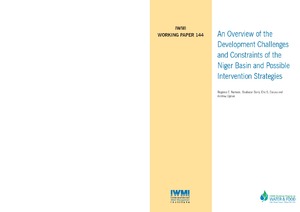Resource information
The Niger River Basin covers 7.5% of the African continent, and is shared between nine riparian
countries. The basin countries can be categorized into water resources producers, consumers, both
producers and consumers, and minimum contributors and consumers. As in the case for most
transboundary rivers, upstream and downstream conflicts emanating from the development and
utilization of the Niger River are inevitable and are expected to be intense, particularly given the
escalating demands for water from the many uses and users. The basin is divided into four major
sections, namely Upper Niger, Inland Delta, Middle Niger, and Lower Niger. But these divisions,
though useful, are too generic to provide a complete understanding of biophysical, hydrological
and socioeconomic processes impinging on the basin’s water resources, and to provide intervention
recommendations. On average, the basin’s population is two-thirds (64%) rural and a significant
part of the northern zones of the basin is unpopulated.
People in the basin are engaged in various livelihood strategies such as dry- and wet-season
cropping systems, pastoral systems, crop-livestock systems, and fishing. The dry-season livelihood
systems include fadama (lowland or inland valleys) farming, recession flood farming, agroforestry,
irrigated rice farming and fishing. Wet-season livelihood systems center mostly on cereal cropping
and transhumance. The major crops grown in the basin are yam, cassava, rice, groundnut, millet,
sorghum, plantain, cocoa, maize, sugarcane, and cotton. Agriculture represents a large part of the
gross domestic product (GDP) of the Niger River Basin with crop production alone contributing
25-35% of the basin’s GDP, while livestock and fishery contribute 10-15% and 1-4%, respectively.
All countries of the Niger Basin suffer from chronic and acute poverty and are ranked ‘poor’
by most poverty indicators (Human Development Index [HDI]), child mortality, life expectancy,
Social Vulnerability Index, etc.). Several structural (social and institutional) factors hold a large
segment of the basin’s population in the throes of poverty. Niger Basin’s challenge is to break this
vicious circle by using resources to generate sustainable growth that is favorable to the poor. Some
of the prominent water-related challenges are degradation of land and water resources, climate
change and variability, vulnerability to disasters, inefficiency and poor performance of agriculture
(rain-fed and irrigation), competing demands between sectors and water users and inadequate
investment in water infrastructure. At a wider level, inadequate public services, institutional and
governance failure, high population growth and urbanization, poor macro-economic performance,
and unemployment have also undermined the development of the basin. The severity of these
challenges varies from location to location in the basin.
The basin’s development goals and objectives originate as a response to the development
challenges and are articulated in various policy documents such as the Niger Basin Shared Vision
(NBA PADD), poverty reduction strategy papers, United Nations (UN) Millennium Development
Goals (MDGs), and the New Partnership for Africa’s Development (NEPAD), specifically the pillars
1, 2, 3 and 4 of the Comprehensive Africa Agriculture Development Programme (CAADP). The
goals of the basin countries are eradicating extreme poverty and hunger; achieving universal primary
education; promoting gender equality and empowerment of women; reducing child mortality;
improving maternal health; combating Human Immunodeficiency Virus (HIV)/Acquired Immune
Deficiency Syndrome (AIDS), malaria and other diseases; ensuring environmental sustainability;
and developing a global partnership for development.
viii
The specific development objectives of the basin countries are the following:
• Increase income, generate jobs, improve living standards, and alleviate poverty, especially
among the poorest section of the population while at the same time safeguarding the
environment including the sustainable management of the Niger Basin water resources.
• Improve access to health and education services, and increase life expectancy.
• Achieve political stability, good governance and an appropriate institutional framework.
• Improve the investment climate for private-sector development where infrastructure plays
a decisive part.
• Develop infrastructures and the productive sector to ensure better productivity of factors
of production and economic growth.
• Reduce food imports, boost agricultural exports through stabilization, intensification and
expansion of agricultural production.
To realize the basin’s development goals and objectives the following water-centered
intervention clusters needed to be synergistically pursued.
• Ensuring right to secure access to water for the poor.
• Developing new infrastructure.
• Improving access to agricultural water management innovations.
• Strengthening Niger Basin’s water governance.
• Upgrading rain-fed systems.
• Reducing the vulnerability of poor people to climate shocks and other hazards.
• Minimizing degradation of the terrestrial and aquatic ecosystems.
• Diversifying livelihood strategies.



